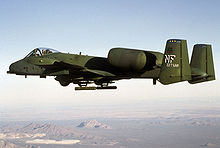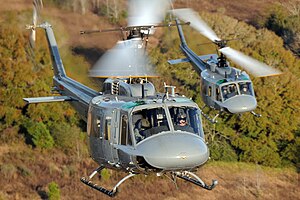|
23rd Flying Training Squadron
The 23rd Flying Training Squadron is a unit of the United States Air Force, currently assigned to 58th Operations Group performing helicopter training at Fort Novosel, Alabama.[3] MissionSince January 1994, the 23d Flying Training Squadron is the United States Air Force's primary source of helicopter pilots for special operations, combat search and rescue, missile support, and distinguished visitor airlift missions. Its mission is providing Air Force helicopter flight training for all undergraduate pilots proceeding to flying careers in the Air Force's UH-1N Huey, HH-60G Pave Hawk or CV-22 Osprey fleets. Tactical training includes alternate insertion and extraction (AIEs) but specialized training like hoists and gunnery is saved for type-qualification in post-graduate flight training at Kirtland AFB, New Mexico to smooth their transition in more complicated aircraft and missions. USAF rotary wing students receive their wings when their Fort Novosel pilot training class is completed. HistoryWorld War IIAntisubmarine operations in the CaribbeanThe 23d's first predecessor is the 76th Bombardment Squadron (Medium) which was activated at Salt Lake City Army Air Base, Utah on 15 January 1941. It was redesignated the 23d Antisubmarine Squadron (Heavy) on 3 March 1943, and assigned to the 26th Antisubmarine Wing and moved to Imeson Field, Jacksonville, Florida with a variety of aircraft (North American B-25 Mitchell, Douglas O-43 and a Douglas B-18 Bolo). Coastal patrols were flown over the southeast coast looking for German U-boats. It deployed to Batista Field, Cuba on 28 February 1943, where it conducted antisubmarine operations until 24 April, then moved to Edinburgh Field, Trinidad on 5 August 1943 and was attached to Antilles Air Command. From Trinidad, was moved to Zandrey Field, Surinam between 15 August 1943 and December. The unit also had elements at NAS Guantanamo Bay, Cuba, and rotated its crews to and from Florida to its far-flung operating elements about every 10 weeks. One flight of the squadron was temporarily stationed at Caracas Airport, Venezuela. With the Navy taking over the antisubmarine mission in mid-1943, the squadron returned to the United States via Borinquen Field, Puerto Rico, where unit personnel were reassigned to other units. It was disbanded on 6 February 1944. Troop carrier operations in EuropeThe second predecessor of the unit was activated as the 23d Troop Carrier Squadron on 21 November 1944 at Pope Field, North Carolina and equipped with Douglas C-47 Skytrains. Assigned to the 349th Troop Carrier Group of IX Troop Carrier Command in England, at RAF Barkston Heath, the unit transported cargo and personnel throughout the European Theater of Operation. Later operated from Advanced Landing Grounds in France, primarily resupply and casualty evacuation airfields, many times unsurfaced close to the front lines. Was upgraded to the Curtiss C-46 Commando in early 1945. Inactivated on 7 September 1946 after serving with the United States Air Forces in Europe as an intra-theater transport squadron supporting the occupation forces in Germany. Helicopter airliftThe activation of the 23d Helicopter Squadron on 9 July 1956, was the result of the inactivation of the 516th Troop Carrier Group (Assault, Rotary Wing). The 516th had been a victim of an Air Force and Army dispute over control of assault helicopters. The squadron was activated at Sewart Air Force Base, Tennessee, and assigned to Eighteenth Air Force. The squadron was formed by absorbing the personnel, aircraft, and equipment of the 345th Troop Carrier Squadron (Assault, Rotary Wing). The squadron moved to Phalsbourg-Bourscheid Air Base France, the squadron arrived at the new base between 7 and 15 November 1956, equipped with Piasecki H-21 helicopters. Built for a tactical fighter wing, Phalsbourg had plenty of hangar space and quarters for the 23d Squadron. It could keep all its H-21Bs indoors. The 23d Helicopter Squadron provided useful general airlift support throughout France. Standard helicopter missions included: Special Airlift Missions, Administrative Support Mission, and Emergency Air Evacuation Missions. It transferred injured U.S. personnel and dependents that required major medical attention to full-service hospitals from remote military sites across Europe. It was assigned to the 322d Air Division at Évreux-Fauville Air Base, France for operational control, mission scheduling, and airlift priorities. The 322d recommended that the 23d Helicopter Squadron be divided into four detachments for greater utilization.
After a year of operation, USAFE felt the limitations of helicopter airlift were not worth the costs, and decided to eliminate the 23d Helicopter Squadron from its force structure after fourteen months in Europe. Also during this same time, the United States Army in France was obtaining similar helicopter airlift capabilities, and the mission of the 23d could be transferred to USAREUR. The squadron was inactivated on 8 January 1958. However, the Detachment at Wheelus was so successful that after the 23d departed France, six of their H-21Bs continued to operate, as part of the 7272d Flying Training Wing. During 1960 the Wheelus helicopters participated in an ongoing long distance rescue mission when they evacuated American and European civilians from the Republic of the Congo (Léopoldville), where they were being threatened by rioting native troops. Vietnam War The final predecessor of the squadron was organized on 15 April 1966 as the 23d Tactical Air Support Squadron at Udorn Royal Thai Air Force Base, Thailand, and operated from Nakhon Phanom Royal Thai Air Force Base, Thailand, from 15 April 1966 – 22 September 1975.[4] The 23d Tactical Air Support Squadron was created out of the personnel and equipment of Detachment 3 of the 505th Tactical Control Group Lt. Col. (selectee) Robert L. Johnston. Lt. Col Johnston selected Nakhon Phanom Royal Thai Air Force Base for operations in the Steel Tiger portion of the Ho Chi Minh Trail between Nape Pass and Tchepone in the Laos Panhandle.[note 1] It was the first USAF combat squadron to be stationed at Nakhon Phanom to operate across the Mekong River over Laos. Its operations would be countered by a North Vietnamese increase in number, type, and caliber of antiaircraft weaponry. By 1972, the Ho Chi Minh Trail would be defended by guns ranging from heavy machine guns to 100mm cannon, and both truck-borne and man-portable surface to air missiles.[5][6][7] Five Forward Air Controller (FAC)s went to Nakhon Phanom in January[clarification needed] to test the idea of working the Steel Tiger portion of the Ho Chi Minh Trail, and many more came there on temporary duty during the following months. Losses of 23d pilots started in March with Capt. Karl Edward Worst, whose plane disappeared 2 March 1966 in an apparent mid-air collision with a Republic F-105 Thunderchief during an air strike.[citation needed] The unit and mission were initially called Operation Cricket, which name the area airborne control ship took for a call sign, and the original pilot call sign was "Gombey". This was changed to "Nail" in mid-1966, and "Nail" remained a call sign until war's end. The 23d also used the call sign "Rustic". The 23d's well-known unit patch featuring Jiminy Cricket with a walkie-talkie and an umbrella was sold to the squadron by Walt Disney for $1 in response to a request from Nail pilot John Taylor.[5]  The 23d, like its sister FAC squadrons based in Vietnam, initially flew Cessna O-1 Bird Dogs in 1966 and into 1968, when the last one was retired. All of its O-1's were the F variant, which featured a variable-pitch propeller. In 1967, the unit began receiving Cessna O-2 Skymasters to replace the O-1s. In 1969, the squadron began to receive North American OV-10 Broncos, and flew that aircraft until the end of the war. Over the course of the war, the 23d lost 7 O-1s, 15 O-2s, and 23 OV-10s.[8] The 23d lost at least 27 pilots during the war, and its pilots received many Air Force combat decorations.[9] On 27 January 1973, one day before the Paris Peace Accords came into effect, a squadron OV-10 Bronco #68-3806, call sign Nail 89 acting as forward air controller for the attempted rescue of a Navy F-4 Phantom II crew, was hit by an SA-7 missile, both crewmen ejected and radio contact was established with one of them who said he was about to be captured. Neither crewman was returned during Operation Homecoming and both are listed as presumptive finding of death.[10][11] On 12 April 1975 the 23d supported Operation Eagle Pull, the evacuation of Phnom Penh, Cambodia.[12] The 23d was inactivated on 22 September 1975.[1] Reactivation in the US The squadron was reactivated on 30 November 1975 at as part of the 602d Tactical Air Control Wing at Bergstrom Air Force Base, Texas, where it trained OV-10 forward air controllers before moving to Davis-Monthan Air Force Base, Arizona on 1 July 1980. The 27th Tactical Air Support Squadron, an O-2A sister squadron, was at Davis-Monthan. The 27th was inactivated and the 23d assumed its mission, personnel and equipment, until it was again inactivated on 1 November 1991.[13] The 23d operated 26 Cessna OA-37 Dragonflys. In September 1985, as part of a program to merge Air Force units formed after World War II with units that had seen service during the war, the 23d Tactical Air Support Squadron was consolidated with its three predecessor units.[1] Helicopter pilot trainingThe squadron was redesignated the 23d Flying Training Flight on 22 December 1993, it was reactivated on 15 January 1994 at Fort Rucker (now Fort Novosel), Alabama as part of the 542d Operations Group at Kirtland Air Force Base, which conducted USAF helicopter training. Reassigned to the 58th Operations Group on 1 April 1994, it was redesignated as the 23d Flying Training Squadron on 21 December 1999. At Fort Rucker, it is housed in three geographically-separated facilities and a simulator facility off-base, the 23d handles academic, simulator, and flight line training. The Beechcraft C-12 Huron was added to the 23d's aircraft inventory in 2000. In addition to the helicopter pilot training, the 23d, with Detachment 5, Air Mobility Command Air Operations Squadron, oversees the formal training for the Air Force's C-12 C/D Super King Air 200. Detachment 5 conducts all USAF C-12 flight evaluations, and also assists HQ DIA/Air Operations in worldwide flight evaluations upon request. Detachment 5, in association with HQ Air Mobility Command develops, publishes, and implements curriculum for several courses, including academics, simulator training, flight training for Air Force C-12 initial qualification and initial instructor qualification. Operations and decorations
Lineage23d Antisubmarine Squadron
23d Troop Carrier Squadron
23d Helicopter Squadron
23d Flying Training Squadron
Assignments
Stations
Aircraft
ReferencesNotes
Bibliography
Further reading
External links |
||||||||||||||||||||||||||||||||||||||







